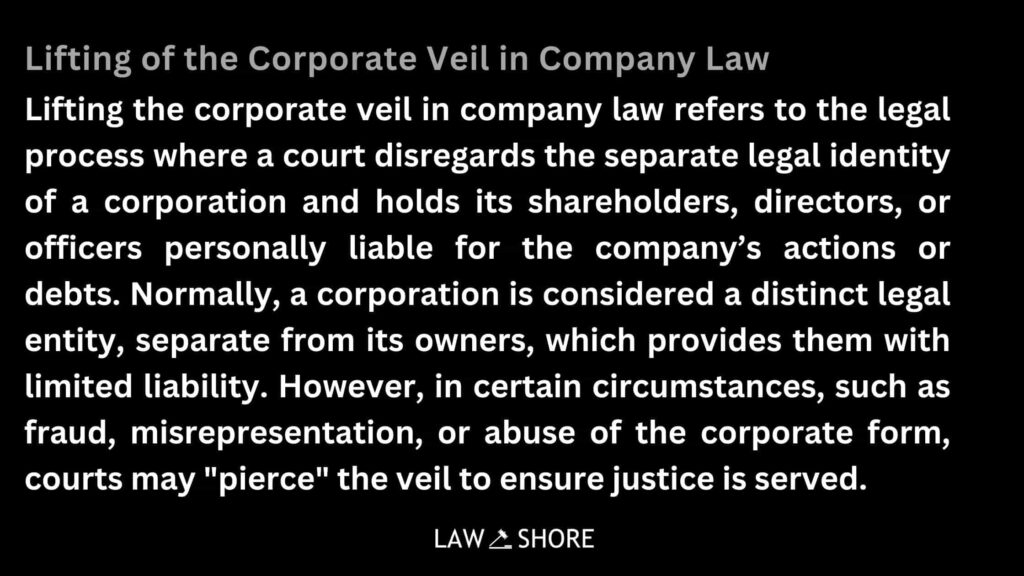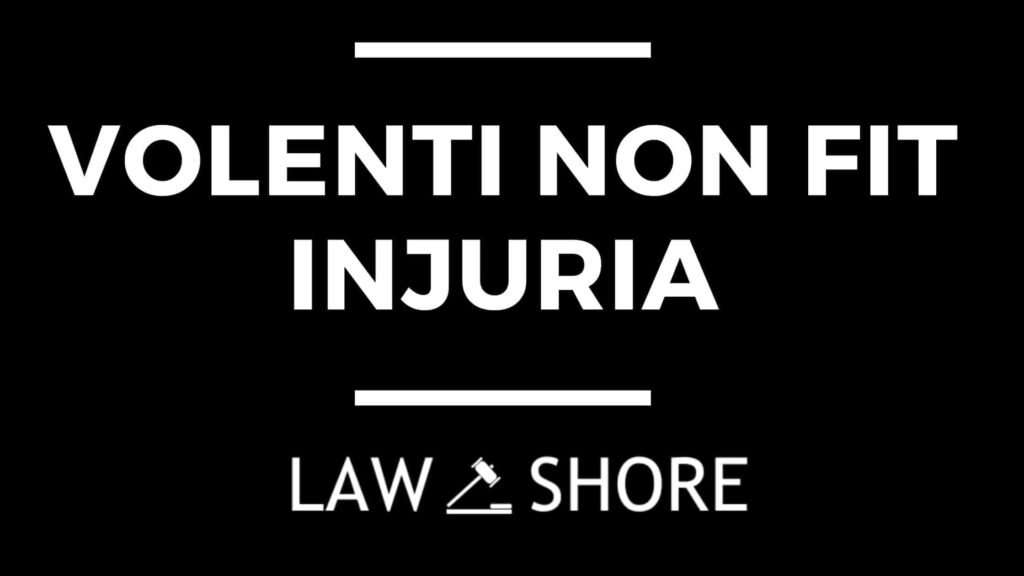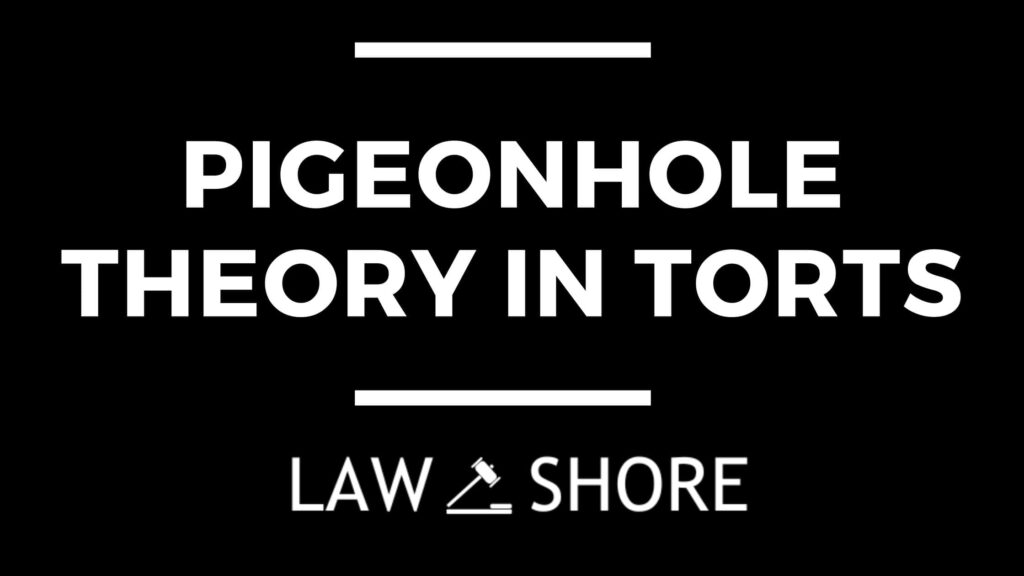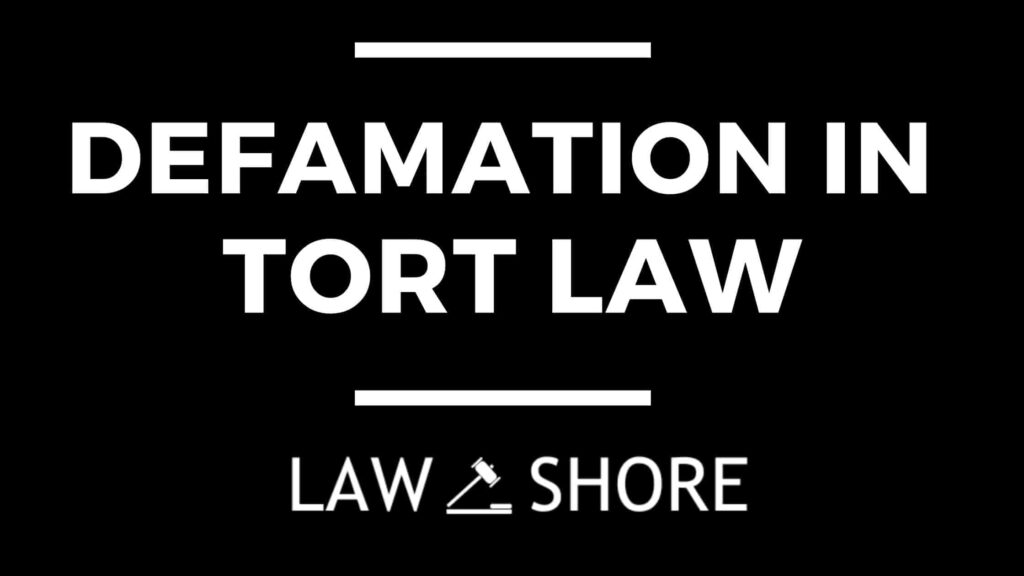Meaning of Volenti non fit injuria
Table of Contents
ToggleThe Latin maxim “Volenti non fit injuria” translates to “No injury is done to one who consents.” In tort law, it signifies that a person who voluntarily accepts a known risk or engages in an activity cannot later claim to have suffered harm as a result of that risk. Essentially, when an individual knowingly and willingly participates in a particular situation, they are deemed to have waived their right to seek legal remedy for any ensuing injury.
This principle is frequently applied in contexts such as sports or recreational activities, where participants are aware of and accept the inherent risks involved. It underscores the notion of personal autonomy and consent, indicating that a person’s voluntary participation inherently involves an acceptance of the potential consequences. However, this defence does not apply in cases involving coercion, fraud, or where the harm incurred exceeds, the risks reasonably anticipated or consented to.

Voluntary Consent
Voluntary consent refers to a situation where an individual willingly and knowingly agrees to partake in a particular activity or assume a certain risk, free from any external compulsion or coercion. The core principle of volenti non fit injuria is that by freely consenting to an activity, a person accepts the inherent risks involved, thereby waiving their right to claim compensation for any resulting harm. The individual’s decision to engage in the activity must be made without any external pressures.
Example: A person who voluntarily chooses to go skydiving is, by doing so, consenting to the risks associated with the activity, such as the possibility of injury during the jump. Their participation, knowing the risks, precludes them from later seeking compensation for injuries sustained during the jump.
Knowledge of Risk
For volenti non fit injuria to apply, the individual must not only consent to the activity but also be fully aware of the risks inherent in it. Mere agreement to participate is insufficient; the individual must comprehend the potential dangers involved. This knowledge of risk justifies the individual’s inability to seek redress later, as their consent is deemed to encompass an acceptance of the possible harm. The awareness of risk is fundamental, as it establishes that the individual knowingly assumed the possibility of injury.
Example: A person who signs a waiver before participating in skydiving understands the risks involved, such as equipment malfunction or injury during the jump. Their informed understanding of these risks forms the foundation of their consent to the activity.
Absence of Coercion
The application of volenti non fit injuria is contingent upon the absence of coercion or undue influence. Consent must be given freely, without duress, threats, or manipulation. If an individual is coerced into participating in a risky activity, their consent is not valid, and they retain the right to seek compensation for any injuries sustained. The presence of coercion undermines the validity of the consent, rendering the individual entitled to legal redress for harm suffered.
Example: If an individual is forced to skydiving under threat or duress, their consent is not considered valid under the maxim. In such circumstances, they may be able to pursue a legal claim for any injuries sustained during the activity, as the consent was not given voluntarily.
Illustration to Explain the Concept:
Scenario: Skydiving Accident
Imagine a person named John decides to go skydiving with a reputable company. Before the jump, John signs a waiver acknowledging the risks involved — such as the potential for the parachute to malfunction, harsh weather conditions, or other dangers associated with jumping from a plane.
- Voluntary Consent: John willingly chooses to participate in the activity. He is not forced or coerced into the experience, and he actively decides to take part in the skydiving adventure.
- Knowledge of Risk: The waiver that John signs before the jump explains all the potential risks associated with skydiving. John reads the document and is aware that there are risks of injury or even death associated with this extreme sport. His understanding of the possible outcomes is essential to his consent.
- Absence of Coercion: John was not threatened or pressured into going skydiving. He made the decision of his own free will, understanding that the activity was inherently risky.
During the jump, John’s parachute malfunctions, leading to a minor injury when he lands. Since John knew the risks and voluntarily consented to take part in the activity, the legal principle “Volenti non fit injuria” would likely apply. He cannot sue the skydiving company for the injury because he consented to the risks involved in skydiving.
Legal Outcome:
In this scenario, the defence of “Volenti non fit injuria” could be used by the skydiving company to argue that John cannot claim damages because he willingly and knowingly assumed the risks by participating in the activity.
In Contrast: Scenario with Coercion
Imagine another scenario where Emma is forced by her friends to join in a skydiving experience against her will. They keep pressuring her, making her feel like she would be a “coward” if she doesn’t participate. She reluctantly agrees, signing the waiver under pressure.
- Voluntary Consent: Emma’s consent was not freely given. She was coerced by her friends and did not truly want to go skydiving.
- Knowledge of Risk: Emma was aware of the risks, but her decision to jump was not based on her own free will.
- Absence of Coercion: In this case, there was coercion, so the principle of “Volenti non fit injuria” would not apply.
If Emma gets injured, she could still have grounds to seek damages because her consent was not voluntarily given, as she was forced into participating.
What is the legal principle behind the maxim "Volenti non fit injuria"?
The legal principle behind the maxim “Volenti non fit injuria” is that a person who voluntarily accepts or consents to a particular risk cannot later claim to have been harmed or injured by that risk. In other words, if an individual knowingly and willingly engages in an activity or situation where harm could occur, they are considered to have given implicit consent to that risk, and thus they are barred from seeking legal redress for any resulting injury.
This principle reflects the idea of personal autonomy and voluntary assumption of risk, meaning that consent absolves others from liability for injuries sustained in circumstances where the individual accepted those risks. It is often applied in cases such as sports, dangerous activities, or situations where the risks are clear and accepted by the participant. However, the maxim does not apply when there is coercion, deceit, or when the harm goes beyond the scope of what was consented to.
How does "Volenti non fit injuria" apply in tort law?
In tort law, the principle of “Volenti non fit injuria” plays a significant role in cases where a claimant seeks compensation for an injury caused by an act they voluntarily consented to or accepted. The maxim holds that if a person voluntarily assumes a known risk, they cannot later claim to have suffered an injury from that risk, thereby preventing them from suing for damages.
For example, in the context of sports, where players voluntarily participate in activities that inherently carry a risk of injury, “Volenti non fit injuria” may be used as a defence to shield defendants (such as other players or organizers) from liability. The participants are presumed to have consented to the risks involved, such as the possibility of accidental injury during the game.
Similarly, in recreational activities like skydiving or bungee jumping, where individuals are made aware of the risks and voluntarily choose to engage in those activities, the defence can be invoked if an injury occurs.
However, the defence is not absolute. It cannot be applied in situations where the injury was caused by acts outside the scope of what was consented to, or if there was fraud, coercion, or a lack of informed consent. Additionally, in cases where the defendant’s conduct was reckless or grossly negligent, “Volenti non fit injuria” may not apply.
What constitutes consent in the context of this doctrine?
Consent can be express (clearly stated) or implied (inferred from behaviour). A court examines if the individual had full knowledge of the risk and willingly accepted it.
EXCEPTIONS
While the maxim “Volenti non fit injuria” suggests that a person who voluntarily accepts a risk cannot claim compensation for injuries resulting from that risk, there are several important exceptions where this principle does not apply. These exceptions ensure that individuals are not unfairly deprived of legal recourse, especially when certain conditions are not met. Below are the key exceptions in depth:
Informed Consent
For “Volenti non fit injuria” to apply, the person must have given informed consent, meaning they must have a clear understanding of the risks involved. If a person is not properly informed of the dangers, or if they were misled or deceived, their consent may not be valid. In such cases, the defence of volenti cannot be used because the individual did not voluntarily accept the risk with full knowledge.
For instance, if a person is participating in a sport and is unaware of a particular, hidden risk (such as a faulty piece of equipment), their consent may not be considered valid because they did not truly know what they were agreeing to.
Lack of Voluntariness (Coercion or Duress)
If the individual was coerced or forced into accepting a risk, then volenti non fit injuria does not apply. The consent must be given voluntarily. If someone is under duress, pressure, or threats, their “consent” is not genuine. Coercion can arise in various situations, such as when an employee is forced to accept unsafe working conditions because they fear losing their job.
Public Policy Considerations (Implied Consent Does Not Apply in Certain Contexts)
Certain activities or circumstances are subject to public policy considerations where the law does not allow a person to waive their rights, even if they voluntarily accept a risk. For example, individuals cannot consent to being harmed by criminal acts, such as assault or battery. Similarly, a person cannot waive their right to sue for injuries caused by extreme negligence or recklessness, as society deems such behaviors to be unacceptable, irrespective of consent.
In situations where public safety or societal norms are at stake, courts may determine that a person cannot be deemed to have consented to harm. For instance, a passenger cannot be considered to have consented to a car crash due to the driver’s reckless driving, even if they voluntarily entered the vehicle.
Excessive or Unreasonable Risks (Beyond the Scope of Consent)
Another exception occurs when the risk exceeds what the individual could have reasonably expected or consented to. If the harm caused goes beyond the nature or scope of the risk the individual voluntarily assumed, then they may still have a valid claim. For example, in sports, players consent to the normal risks involved in playing, like being accidentally tackled. However, if a player intentionally causes harm (e.g., through violent conduct), the injured party can still claim compensation, as such actions exceed the normal risks of the game.
Recklessness or Gross Negligence
If the defendant’s actions were reckless or grossly negligent, volenti non fit injuria may not apply. The law does not allow individuals to waive claims when the defendant’s conduct is so egregious that it falls outside the reasonable bounds of normal risk. Recklessness refers to situations where the defendant knows there is a risk but disregards it in an extreme or unjustifiable manner, whereas gross negligence refers to a severe lack of care or an extreme departure from the standard of care.
For example, if a person is injured in a bungee jumping accident due to the operator’s failure to properly inspect equipment, their voluntary participation in the activity does not absolve the operator of liability if their conduct was grossly negligent.
Statutory Protections
In some jurisdictions, statutory laws provide certain protections that override the principle of volenti non fit injuria. These laws are designed to protect individuals from being unable to claim compensation due to their consent. For example, consumer protection laws might prohibit businesses from using volenti as a defence in cases involving unsafe products, even if a consumer knowingly uses a risky product.
Professional Duty (Special Relationships)
In some cases, professionals (such as doctors or employers) have a special duty of care to those they serve. Even if a person voluntarily participates in an activity, such as undergoing a medical procedure, the professional may still be held liable if their conduct falls below the standard of care, or if they do not fully inform the patient of the risks involved.
In summary, “Volenti non fit injuria” is a powerful legal principle but is subject to several exceptions that ensure fairness and justice in cases where consent was not truly voluntary, informed, or reasonable, or where public policy considerations demand additional protections.
How does "Volenti non fit injuria" differ from the defence of "contributory negligence"?
“Volenti non fit injuria” and “contributory negligence” are both defences used in tort law, but they are distinct in terms of their focus and application.
- Volenti non fit injuria is a defence based on the idea that a person who voluntarily accepts a risk cannot later claim compensation for any harm resulting from that risk. It involves the assumption of risk, where the individual knowingly and willingly engages in an activity with the awareness of the potential for injury. This defence is often used in cases where the injured party agreed to participate in an activity that inherently carries risks, such as sports or dangerous activities. The key element here is the voluntary acceptance of the risk.
- Contributory negligence, on the other hand, is a defence that arises when the injured party is partially responsible for their own injury due to their own negligence. It suggests that the plaintiff’s actions or failure to take reasonable care contributed to the harm they suffered. Unlike volenti, contributory negligence focuses on the individual’s own behavior that contributed to the injury, even if the defendant’s actions were also a cause. In jurisdictions where contributory negligence applies, if the plaintiff is found to be even slightly at fault, they may be barred from recovering damages.
Key Differences:
Aspect | Volenti non fit injuria | Contributory Negligence |
|---|---|---|
Basis | Voluntary assumption of risk | Plaintiff’s own negligence |
Focus | Consent to the risk, waiver of right to claim | Plaintiff’s failure to exercise reasonable care |
Application | Used when a person knowingly accepts a risk in an activity | Used when a person contributes to their own injury through carelessness |
Effect on Liability | Bars the claim entirely if consented to risk | Reduces the claim based on the percentage of plaintiff’s fault (or barring it in contributory negligence jurisdictions) |
Example | A person injured while playing football voluntarily accepts the risk of injury | A person is hit by a car because they were jaywalking, contributing to the accident |
Degree of Fault | No fault from the defendant is necessary; the focus is on the plaintiff’s consent | The defendant’s fault is considered, and the plaintiff’s negligence is assessed as a contributing factor |
Impact on Damages | No damages can be awarded if the person consented to the risk | Damages may be reduced by the percentage of the plaintiff’s contribution to the injury |
In summary, “Volenti non fit injuria” relates to the voluntary acceptance of risk, whereas “contributory negligence” deals with the plaintiff’s own negligent actions that contribute to their injury. Both defences can limit or bar claims, but they operate under different principles and conditions.
Relation of "Volenti non fit injuria" to "Informed Consent" in Healthcare
In healthcare, the principle of “Volenti non fit injuria” intersects with the concept of informed consent in important ways. Both principles involve a person’s voluntary decision to engage in an activity with full knowledge of the potential risks involved.
- Informed Consent: In healthcare, informed consent refers to the process by which a patient is provided with sufficient information about the potential risks, benefits, and alternatives to a proposed treatment or procedure. The patient must understand these factors and voluntarily agree to undergo the procedure. This ensures that the consent is given freely and knowingly.
- Volenti non fit injuria: This maxim applies in situations where a person voluntarily accepts the risks associated with a particular action, thereby waiving the right to seek compensation for any harm that results. In healthcare, when a patient gives informed consent to a medical procedure, they are, in a sense, voluntarily accepting the risks involved, and under volenti, they cannot later claim an injury solely due to the inherent risks of the procedure. However, if the healthcare provider fails to disclose critical information, or if there is negligence beyond the normal risks, the defence of volenti might not apply.
In this context, informed consent ensures that the consent is valid by confirming that the patient is fully aware of the risks they are agreeing to. If a healthcare provider fails to obtain informed consent, volenti non fit injuria may not be used as a defence if the patient later sues for an injury.
Can a Person Revoke Their Consent After Engaging in a Risky Activity?
Under “Volenti non fit injuria“, a person cannot generally revoke their consent after voluntarily engaging in a risky activity, especially if they have already accepted the risks involved at the time of participation. This is because Volenti is based on the premise that, by consenting, a person waives their right to compensation for harm resulting from the inherent risks of the activity. Once consent has been given and the person voluntarily participates, it’s difficult to later withdraw that consent and seek compensation for the risks they accepted.
However, there are exceptions:
- Revocation Before Injury: If a person withdraws their consent before the activity begins or while it is ongoing (e.g., during a medical procedure), the waiver of liability may no longer apply. For instance, in healthcare, a patient has the right to revoke consent at any point before the procedure is completed, especially if they feel they were not adequately informed or if the circumstances have changed.
- Change in Risk or Circumstances: If the conditions of the activity change or if new risks emerge during the activity (such as negligence or actions that go beyond what was initially consented to), a person may argue that the consent was effectively withdrawn. In such cases, even though the person initially accepted the risks, their continued participation under altered conditions could be contested.
Volenti non fit injuria Case laws
Smith v. Baker & Sons (1891)
Fact of the Case: In Smith v. Baker, the plaintiff was employed as a worker at a quarry. While working, large stones were being hoisted overhead, and one stone fell and injured him. The plaintiff argued that his employer was negligent in allowing the stones to be hoisted in such a manner, creating a dangerous situation. The employer contended that the plaintiff had voluntarily assumed the risk as part of his job.
Key Observation: The House of Lords held that the plaintiff did not voluntarily assume the risk of injury. Although the worker was aware of the risk involved in the job, the employer’s failure to provide a safe working environment meant that the plaintiff was not barred from claiming compensation. The court emphasized that knowledge of a risk does not necessarily mean voluntary consent to that risk, especially when there is a duty of care owed by the employer.
Applicability of the Maxim: This case demonstrates that volenti non fit injuria does not apply when the defendant’s negligence creates or exacerbates the risk. Simply being aware of the risk or engaging in an activity does not automatically absolve the defendant from liability if they fail to ensure safety.
Haynes v. Harwood (1935)
Fact of the Case: In Haynes v. Harwood, a police officer was injured while attempting to stop a runaway horse and cart. The defendant, who had left the horse unattended and unsecured, was negligent in failing to prevent the horse from running away. The police officer, although aware of the risks, tried to stop the runaway horse and was injured in the process.
Key Observation: The court ruled in favour of the plaintiff, stating that the police officer did not voluntarily assume the risk. Even though the officer was aware of the potential danger, he was performing his duty and acting in the interest of public safety. The court emphasized that the act was not voluntary in the sense required to invoke volenti non fit injuria.
Applicability of the Maxim: The case clarifies that volenti non fit injuria does not apply when the plaintiff is acting under a duty or obligation to the public, and the defendant’s negligence was the main cause of the injury. The maxim does not bar claims in such circumstances, especially when the plaintiff’s actions are in response to a situation created by the defendant.
Simms v. Leigh Rugby Football Club (1969)
Fact of the Case: In Simms v. Leigh Rugby Football Club, the plaintiff was a rugby player who was injured during a game. He sued the rugby club for failing to protect him from an injury caused by rough play. The defendant argued that the plaintiff had voluntarily assumed the risk of injury by participating in the sport.
Key Observation: The court ruled in favor of the defendant, applying the maxim volenti non fit injuria. The judge held that by voluntarily participating in a contact sport like rugby, the plaintiff had knowingly accepted the risks inherent in the game, including the possibility of injury. The court reasoned that players in contact sports accept the risks as part of the nature of the activity.
Applicability of the Maxim: This case is a classic example of the application of volenti non fit injuria. The court emphasized that when individuals engage in inherently risky activities like rugby, they are deemed to have consented to the normal risks involved. As such, the plaintiff could not claim damages for injuries arising from the risks he voluntarily assumed.
These cases illustrate how the maxim “Volenti non fit injuria” is applied in tort law, with varying outcomes based on the specific facts of each case:
- Smith v. Baker & Sons: Knowledge of risk does not equate to voluntary consent if the defendant is negligent.
- Haynes v. Harwood: The maxim does not apply when the plaintiff is acting under a duty or obligation to the public.
- Simms v. Leigh Rugby Football Club: The maxim applies when individuals voluntarily participate in risky activities like sports, acknowledging and assuming the risks involved.
BURDEN OF PROOF
In tort law, particularly in cases involving the maxim “Volenti non fit injuria”, the burden of proof plays a crucial role in determining whether the defence is successfully invoked. Generally, the burden of proof lies with the defendant to establish that the plaintiff voluntarily accepted the risks associated with the activity that led to their injury. However, the specific application can vary depending on the case, the nature of the activity, and the circumstances involved.
General Principles of Burden of Proof under Volenti Non Fit Injuria
- Defendant’s Burden: The defendant must prove that the plaintiff voluntarily accepted the risk of harm. This usually involves showing that the plaintiff had knowledge of the risks and chose to participate in the activity anyway. This could be shown through evidence of the plaintiff’s participation in an inherently risky activity, or the plaintiff’s explicit or implied consent to the risks involved.
- Plaintiff’s Knowledge and Voluntary Consent: In cases invoking volenti, the defendant typically must establish that the plaintiff not only knew about the risks but actively accepted them. For example, in sporting activities or high-risk professions, the defendant may argue that the plaintiff, by engaging in the activity, voluntarily assumed the inherent risks.
- Burden Shifting in Certain Cases: Once the defendant has provided evidence suggesting that the plaintiff assumed the risk, the burden may shift to the plaintiff to show that they did not voluntarily assume the risk or that the risks involved were outside the scope of what they had consented to.
Case Law Examples Regarding Burden of Proof
1. Case: Smith v. Baker & Sons (1891)
Burden of Proof: In this case, the defendant argued that the plaintiff, a worker in a quarry, had voluntarily accepted the risk of injury by engaging in the work. However, the defendant had to prove that the plaintiff had actual knowledge of the risk and had voluntarily chosen to work under those dangerous conditions. The court found that the employer was negligent in failing to provide a safe working environment, and the burden was not met by the employer.
Key Burden of Proof Aspect: The defendant (employer) failed to prove that the plaintiff had voluntarily assumed the risk because it was established that the employer’s negligence contributed to the hazardous working conditions. Therefore, the burden of proof on the defendant to establish volenti was not satisfied.
2. Case: Simms v. Leigh Rugby Football Club (1969)
Burden of Proof: In this case, the defendant rugby club argued that the plaintiff, a rugby player, had voluntarily assumed the risk of injury by participating in the sport. The court accepted this argument because rugby is inherently a contact sport with known risks, and the plaintiff’s voluntary participation in the game was sufficient to demonstrate consent to those risks.
Key Burden of Proof Aspect: The defendant rugby club succeeded in proving that the plaintiff had voluntarily assumed the risks of injury inherent in the game. The burden of proof was met by demonstrating that, by engaging in the sport, the plaintiff consented to the risks associated with it.
Summary of Burden of Proof in Volenti Non Fit Injuria Cases
Aspect | Defendant’s Burden of Proof | Plaintiff’s Burden of Proof |
|---|---|---|
General Principle | Defendant must prove that the plaintiff had knowledge of and consented to the risk. | Plaintiff may need to prove that they did not consent to or assume the risk or that the risk was outside their reasonable expectations. |
Employer’s Burden | Employer must prove that the worker voluntarily accepted the risk and that it was a known and inherent part of the job. | Worker may need to show that they were not informed of the specific risks or that employer negligence was a contributing factor. |
Sports and Recreational Activities | Defendant must prove that the plaintiff voluntarily assumed the risks inherent in the activity. | Plaintiff may need to show that they did not voluntarily accept the risks or that the harm was caused by actions beyond the usual scope of the activity. |
Public Duty Situations | Defendant must prove that the plaintiff voluntarily assumed the risk. | Plaintiff may argue that they were acting in the public interest (e.g., a police officer), and thus volenti does not apply. |
What are the key elements that must be proven for “volenti non fit injuria” to apply?
To apply this defense, the defendant must prove that:
- The claimant was aware of the risk.
- The claimant voluntarily accepted the risk.
- The injury occurred due to the very risk the claimant consented to.
Conclusion
In conclusion, volenti non fit injuria is a significant legal doctrine that emphasizes the principle that a person cannot claim compensation for harm caused by risks they voluntarily accepted. Whether it is applied in tort law, sports, medical procedures, or hazardous work environments, the doctrine serves to balance personal responsibility with legal protection.
However, its application is not absolute—courts carefully assess whether consent was informed and voluntary, ensuring it does not undermine public policy, safety, or fairness. This defense also has limitations, especially in cases involving gross negligence, illegal acts, or when the individual lacks full capacity to consent. As such, while volenti non fit injuria offers a valuable shield for defendants, it must be applied thoughtfully to avoid injustice and ensure that individuals are not unfairly deprived of their legal rights.
Also, Check Out Other Topics in Law of Torts:
Explore Law Shore: law notes today and take the first step toward mastering the fundamentals of law with ease.

After Completing my LLB hons, I started writing content about legal concepts and case laws while practicing. I finally started Law Shore in 2024 with an aim to help other students and lawyers.



